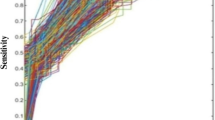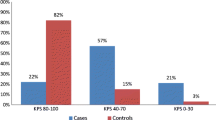Abstract
Venous thromboembolism (VTE) poses a significant risk to patients undergoing cancer treatment, particularly in the context of advanced and metastatic disease. In the realm of neuro-oncology, the incidence of VTE varies depending on tumor location and stage, with certain primary and secondary brain tumors exhibiting a higher propensity for thrombotic events. In this study, we employ advanced machine learning techniques, specifically XGBoost, to develop identifying models for predictors searching associated with VTE risk in patients with gliomas. By comparing the diagnosis testing accuracy of our XGBoost models with traditional logistic regression approaches, we aim to enhance our understanding of VTE prediction in this population. Our findings contribute to the growing body of literature on thrombosis risk assessment in cancer patients and may inform the development of personalized prevention and treatment strategies to mitigate the burden of VTE in individuals with gliomas at the hospital term.
Access this chapter
Tax calculation will be finalised at checkout
Purchases are for personal use only
Similar content being viewed by others
References
Nicholson, M., Chan, N., Bhagirath, V., Ginsberg, J.: Prevention of venous thromboembolism in 2020 and beyond. J. Clin. Med. 9, 1–27 (2020). https://doi.org/10.3390/jcm9082467
Kearon, C., et al.: Antithrombotic therapy for VTE disease: CHEST guideline and expert panel report. Chest 149(2), 315–352 (2016). https://doi.org/10.1016/j.chest.2015.11.026
Connors, J.M., Levy, J.H.: COVID-19 and its implications for thrombosis and anticoagulation. Blood 135, 2033–2040 (2020). https://doi.org/10.1182/BLOOD.2020006000
Xu, Q., Lei, H., Li, X., Li, F., Shi, H., Wang, G., Sun, A., Wang, Y., Peng, B.: Machine learning predicts cancer-associated venous thromboembolism using clinically available variables in gastric cancer patients. Heliyon 9(1) (2023). https://doi.org/10.1016/j.heliyon.2022.e12681
He, L., Luo, L., Hou, X., Liao, D., Liu, R., Ouyang, C., Wang, G.: Predicting venous thromboembolism in hospitalized trauma patients: a combination of the Caprini score and data-driven machine learning model. BMC Emergency Med. 21(1) (2021). https://doi.org/10.1186/s12873-021-00447-x
Lin, C.C., et al.: Derivation and validation of a clinical prediction model for risks of venous thromboembolism in diabetic and general populations. Medicine 100(39), E27367 (2021). https://doi.org/10.1097/MD.0000000000027367
Gerotziafas, G.T., Papageorgiou, L., Salta, S., Nikolopoulou, K., Elalamy, I.: Updated clinical models for VTE prediction in hospitalized medical patients. Thromb. Res. 164, S62–S69 (2018). https://doi.org/10.1016/j.thromres.2018.02.004
Beal, E.W., Tumin, D., Chakedis, J., Porter, E., Moris, D., Zhang, X. feng, Abdel-Misih, S., Dillhoff, M., Manilchuk, A., Cloyd, J., et al.: Identification of patients at high risk for post-discharge venous thromboembolism after hepato-pancreato-biliary surgery: which patients benefit from extended thromboprophylaxis? HPB 20(7), 621–630 (2018). https://doi.org/10.1016/j.hpb.2018.01.004
Lee, E.J., Chang, C.H., Wang, L.C., Hung, Y.C., Chen, H.H.: Two primary brain tumors, meningioma and glioblastoma multiforme, in opposite hemispheres of the same patient. J. Clin. Neurosci. 9(5), 589–591 (2002). https://doi.org/10.1054/jocn.2002.1086. PMID: 12383424
Farge, D., Frere, C., Connors, J.M., Khorana, A.A., Kakkar, A., Ay, C., Muñoz, A., et al.: 2022 international clinical practice guidelines for the treatment and prophylaxis of venous thromboembolism in patients with cancer, including patients with COVID-19. Lancet Oncol. 23, e334–e347 (2022). https://doi.org/10.1016/S1470-2045(22)00160-7
Acknowledgements
This work was supported by Russian Science Foundation, Grant № 23-11-00346.
Author information
Authors and Affiliations
Corresponding authors
Editor information
Editors and Affiliations
Rights and permissions
Copyright information
© 2024 The Author(s), under exclusive license to Springer Nature Switzerland AG
About this paper
Cite this paper
Leontev, S. et al. (2024). Development of a VTE Prediction Model Based on Automatically Selected Features in Glioma Patients. In: Franco, L., de Mulatier, C., Paszynski, M., Krzhizhanovskaya, V.V., Dongarra, J.J., Sloot, P.M.A. (eds) Computational Science – ICCS 2024. ICCS 2024. Lecture Notes in Computer Science, vol 14835. Springer, Cham. https://doi.org/10.1007/978-3-031-63772-8_34
Download citation
DOI: https://doi.org/10.1007/978-3-031-63772-8_34
Published:
Publisher Name: Springer, Cham
Print ISBN: 978-3-031-63771-1
Online ISBN: 978-3-031-63772-8
eBook Packages: Computer ScienceComputer Science (R0)




